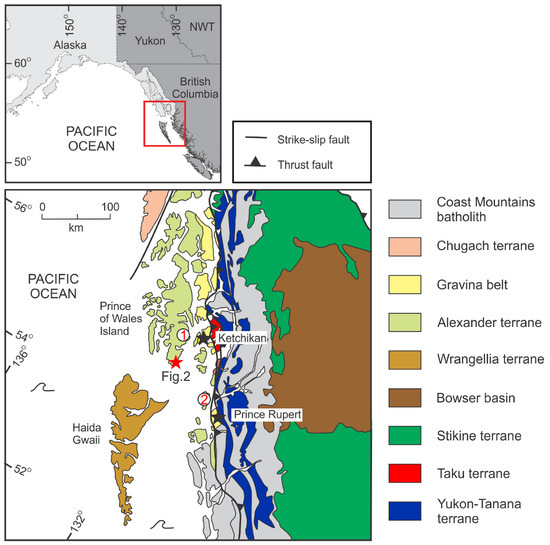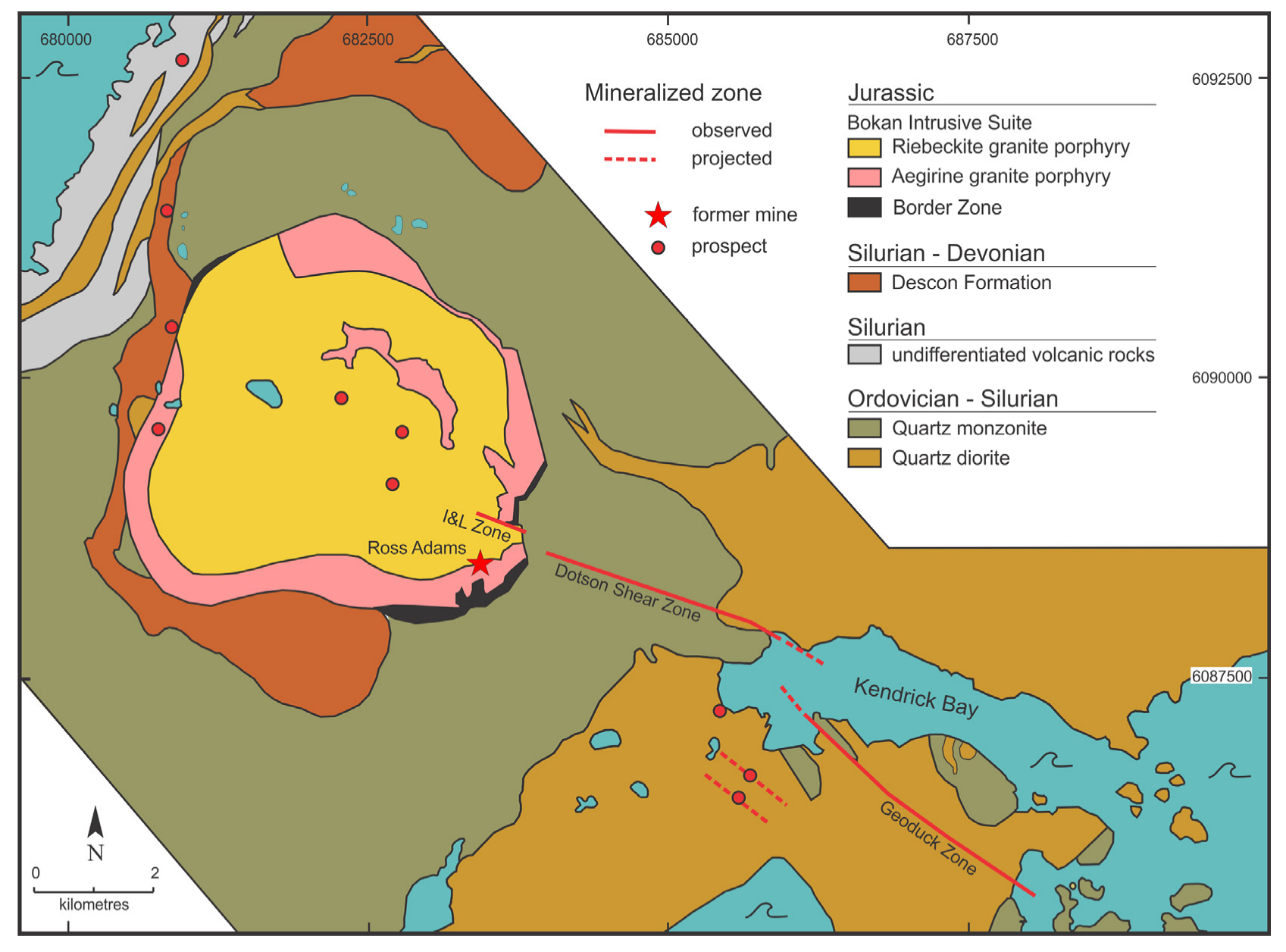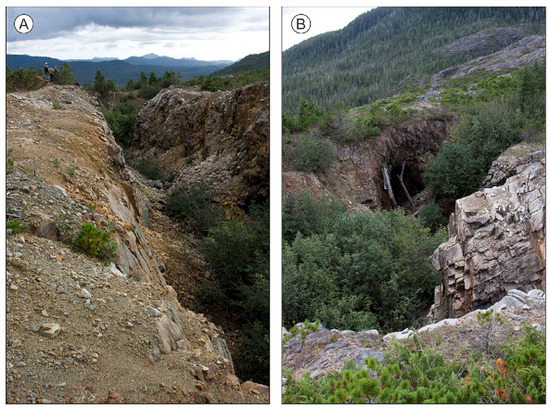2. Geologic Setting and Petrography
BMC lies within the Alexander Terrane of the North American Cordillera (
Figure 1). The Cordillera consists of allochthonous oceanic and pericratonic terranes that were accreted to the northwestern margin of Laurentia (the North American craton) between late Paleozoic and early Cenozoic time (e.g.,
[18][21]). The Alexander terrane is a large outboard allochthonous terrane, which is considered to have an exotic nature with respect to the Laurentian margin (e.g., lack paleontological affinities with North America;
[19][20][22,23]). The terrane (
Figure 1) was accreted to the North American craton by the middle Cretaceous (~115–95 Ma), well after the emplacement of the Bokan complex.
Figure 1. Terrane map of southeastern Alaska and west coast of British Columbia. The map shows the location of Figure 2, the geological map of the Bokan Mountain Complex, southern Prince of Wales Island. The insert shows the location of Figure 1. Sites: 1—Dora Bay pluton; 2—Moffat volcanic rocks.
The basement of southern Prince of Wales Island is composed of the Neoproterozoic to Lower Cambrian Wales Group made up of arc-related volcanic rocks, sedimentary rocks and granitoid intrusions, which were all metamorphosed during the Middle Cambrian to Early Ordovician Wales orogeny. These rocks were unconformably overlain by Ordovician–Early Silurian oceanic arc-related metavolcanic and metasedimentary rocks and intruded by plutons composed mainly of Late Ordovician to Early Silurian quartz monzonites, quartz diorites, diorites and gabbros. The Paleozoic units were metamorphosed during the Klakas orogeny (Middle Silurian to earliest Devonian;
[21][26]). These rocks, which represent an oceanic arc complex
[21][26], host the Bokan stock. Mesozoic rocks are rare in this part of the terrane. Early Jurassic igneous rocks in the Alexander terrane are limited to the BMC, the Dora Bay pluton composed of peralkaline granites and syenite and located about 30 km N of the BMC and bimodal Moffat volcanic rocks 100 km to SE of the BMC (
Figure 1), all dated at ~175–185 Ma
[22][23][25,27].
The Bokan Mountain pluton is a typical anorogenic granitic complex, emplaced at a shallow depth. It produced the contact metamorphic assemblages which included andalusite (chiastolite)-bearing hornfels. Around the intrusion, the Paleozoic country rocks, particularly granitoids, are albitized. A wide (>1 km;
[24][28]) aureole of albitization was produced by infiltration of hydrothermal fluids related to the pluton.
The Bokan granites have variable grain size, ranging from fine to coarse-grained. They are composed typically of quartz and feldspars with 2–10 vol.% of mafic minerals (sodic amphibole-arfvedsonite and sodic clinopyroxene-aegirine in various proportions). Locally, the mafic minerals comprise about 30 vol.% of the rocks. The granites are mainly made up of quartz (~25–45 vol.%), K-feldspar (20–30 vol.%) and albite (30–50 vol.%). The intrusion (
Figure 2) is composed of two main zones
[25][26][29,30]: (1) a core made up of arfvedsonite-bearing granite (porphyry) that forms the main part of the body and (2) an outer ring comprised predominantly of aegirine-bearing granite. The aegirine granite forms a nearly complete circular zone around the core
[25][27][29,31]. A transition unit between these two zones is composed of aegirine-arfvedsonite granite and is typically about 15 m wide. In addition, there is a discontinuous outermost border zone composed of pegmatitic pods with aegirine and arfvedsonite crystals enclosed in aplitic rocks. Fine-grained aegirine granite, which outcrops in the central part of the stock probably represents the preserved roof of the intrusion
[5]. The intrusion is associated with the quartz-feldspatic (felsic) dikes, which occur throughout the intrusions as well as outside, mainly along shear or fault zones. The dikes, composed mainly of quartz, albite and K-feldspar, form elongated lenses, which are steeply dipping and commonly 0.1 to 3 m thick. They include both aplitic and pegmatitic types. Most of them are rich in REE, Nb, Ta, Zr, Pb, Th and U and are closely related to the Bokan intrusion
[28][29][30][18,19,32].
Figure 2. Geological sketch map of the Bokan Mountain complex and surrounding area showing the location of the former Ross-Adams mine and mineralization prospects including mineralized zones.
The granitic rocks have diverse texture although two main textures are dominant—primary porphyritic and late protoclastic
[5][25][28][5,18,29]. The porphyritic texture contains phenocrysts of subhedral to euhedral quartz that ranges from 5 to 20 mm in diameter and K-feldspar enclosed in a fine-to medium-grained groundmass made up of quartz, albitic feldspar and minor K-feldspar. The protoclastic textures are characterized by broken phenocrysts of quartz and feldspars, bending of feldspar twining and pronounced undulose extinction of quartz crystals. Protoclastic textures resulted from an overpressure of fluids generated during the exsolution of the vapor phase from the magma during late stages of crystallization
[5].
K-feldspar occurs as microperthite and cross-hatched microcline while plagioclase (An < 10) forms both a separate phase or an intergrowth or replacement of K-feldspar. Albite pervasively replaces K-feldspar, both in phenocrysts and in the groundmass
[28][29][18,19]. The groundmass is dominated by albite and quartz with subordinate K-feldspar where the primary assemblage is overprinted by the metasomatic assemblage. All the major minerals have formed during at least two stages, one magmatic and the other related to late-stages (late magmatic to post-magmatic). Albite ranges from magmatic crystals to late- to post-magmatic albitic growth from a fluid phase. The albite is generally euhedral without signs of alteration. Quartz has also crystallized during two stages, initially, as the early megacrysts and then in the matrix and as veinlets. Well-developed early quartz crystals were intruded by the quartz veinlets of the second generation. There are also at least two generations of K-feldspar. Early K-feldspar, now occurring as a cross-hatched microcline, is enclosed/embayed by microperthitic K-feldspar that is the main K-feldspar phase. Around the Ross-Adam deposit, Cuney and Kyser
[5] recognized two stages of alteration of the granites. The first stage included albitization of K-feldspar followed by the second stage, where albitization was accompanied by quartz dissolution leading to the generation of secondary syenitic rocks. This rock type is composed primarily of albite and aegirine with accessory fluorite, monazite, zircon and Fe-Ti oxides. The U-Th mineralization is closely associated with the syenitic rock
[5][31][32][5,33,34]. The ore zone appears to be a strongly altered syenitic rock.
The sodic amphibole (arfvedsonite) occurs as subhedral prismatic crystals 1–4 mm long, which are distinctly pleochroic (lilac to blue) and interstitial. It also displays at least two-stages of growth. The inclusion-rich amphibole cores (stage 1) are surrounded an inclusion-free overgrowths (stage 2). Amphibole is commonly replaced by a mixture of secondary minerals (frequently hematite and quartz) or by fibrous aegirine and hematite with interstitial quartz and minor fluorite. Aegirine forms a variety of crystal shapes ranging from equant to prismatic or skeletal. Like arfvedsonite, it also shows a two-stage growth history. Philpotts et al.
[30][32] argued that some aegirine grains might be of hydrothermal origin. Pyroxene and amphibole may be spatially associated but in other samples only one or the other is present. Where both minerals are present, the anhedral to euhedral amphibole partly encloses and corrodes the pyroxene but in some cases pyroxene post-dates amphibole. This association suggests overlapping crystallization of these two minerals. Amphibole and pyroxene are poikilitic, enclosing crystals of quartz, microcline and albite. Individual major rock forming minerals display only limited chemical variations
[28][30][18,32]. Granitic rocks of the BMC host numerous accessory mineral phases. Particularly common are zircon, monazite, xenotime, titanite, fluorite and Fe-Ti oxides. Some of the accessory minerals including monazite could be late/post-magmatic.
The analyzed rocks from a wider vicinity of the Ross-Adams mine were subdivided into four groups—unaltered granites (group 1), albitized granites (group 2), mineralized albitized granites (group 3) and syenites (group 4) although there are transitions among the groups. Group 2 differs from group 1 by distinct albitization. Albite pervasively replaces K-feldspar, both phenocrysts (especially along the fractures and cleavage planes) and grains in the groundmass. The groundmass is dominated by albite and quartz. The accessory mineralogy appears to be the same as in group 1. Group 3 contains notably higher amounts of accessory minerals. In addition to ubiquitous accessory minerals such as zircon, monazite, xenotime, titanite, fluorite and Fe-Ti oxides, more than twenty U-Th-, REE- and HFSE-bearing minerals have been identified at the Bokan complex (e.g.,
[29][30][33][19,32,35]). Some of these minerals are variably present in mineralized altered granites and may occur in two or more generations. Group 4 includes a syenite, a fine-grained rock, which is likely the result of albitization and desilicification of the rocks in the proximity of the mineralization
[5]. Quartz occurs in this rock only in subordinate amounts.
3. History of Mining and Exploration
After the 1955 uranium discovery in shear zones of the BMC by airborne and subsequently ground surveys
[25][29], mining commenced in 1957 mainly due to incentive programs provided by the US Atomic Energy Commission
[34][35][36,37]. The uranium mine was in operation intermittently between 1957 and 1971 and produced roughly 77,000 metric tons of ore averaging about 0.76 wt.% U
3O
8 and 3 wt.% ThO
2 [33][35][36][35,37,38]. These concentrations are among the highest grades of U and Th ores ever mined in the United States and the Bokan is the only uranium deposit to have been mined in Alaska. The uranium ore was mined initially in a small open pit (50 × 110 × 7 m deep
[34][35][36,37] located on the southeastern flank of Bokan Mountain at the Ross-Adams site (
Figure 3). As the irregular cylindrical-shaped ore body plunges steeply at the end of pit, the deposit was subsequently developed as an underground operation through the establishment of two haulage adits (mine entrances). Ore was shipped by barge from the property to continental U.S. for processing, to fulfill contracts with the U.S. Atomic Energy Commission
[1]. The mine stopped operations in 1971, due to depressed prices for uranium, leaving some uranium ore in the ground
[36][38]. Subsequently, several companies carried out exploration in the BMC area during 1971–1981
[31][35][36][33,37,38].
Figure 3. (A) Abandoned Ross-Adams open-pit mine; (B) A southern part of the Ross-Adams pit mine with an adit. Host granites show distinct fracture-cleavages parallel to faults, which controlled emplacement of the deposit.
In addition to the Ross-Adam site, historic exploration has resulted in the delineation of several mineral prospects within or proximal to the BMC, some of which contained significant levels of REE, Y, Zr and Nb, in addition to U and Th
[25][33][36][29,35,38]. Warner and Barker
[36][38] predicted important resources of Th, REE, Y, Zr, Nb and Ta in the complex, in addition to potentially commercial resources of uranium remaining in and around the Ross-Adams mine.
After several years of hiatus, new exploration activities started in 2007 and continued to the present. The exploration targets shifted from uranium to REE and particularly focused on a prospect called the Dotson zone, a cluster of felsic dikes more than 2 km long (
Figure 2), which lies just outside (within 1 km) of the Bokan stock
[29][19]. The mineral resource estimation for the REE ore at the Dotson zone yielded 4.9 million metric tons of ore containing 0.61 wt.% oxides of REE and Y with a high ratio of heavy REE/total REE (heavy REE + Y/total REE + Y = ~0.6;
[37][39]).





